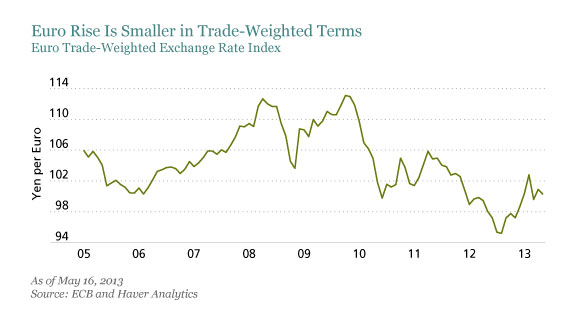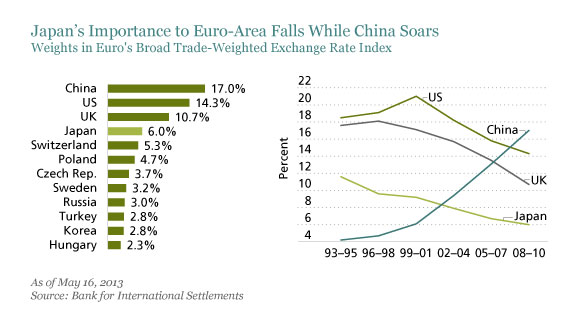As the yen continues to plummet, exporters around the world are growing concerned that Japanese rivals may gain a competitive advantage. But our analysis suggests that the euro-area economy may not be quite as vulnerable as widely perceived.
Since early November, when the Japanese parliament was dissolved, the yen’s trade-weighted exchange rate has fallen by 22%. But let’s put this move in perspective: the yen’s recent decline has unwound only half of its rise between late 2008 and the middle of 2012. Moreover, Japan is not the euro area’s only external competitor. What matters for the overall economy is the euro’s trade-weighted exchange rate, which has risen by just 3% over the last six months (display).

How Important Is Japan?
In terms of direct trade, Japan is no longer a key bilateral trading partner for the euro area. Last year, Japan accounted for just 2.4% of euro-area exports, much lower than the UK (12.3%) or the US (12.0%), and roughly on par with Hungary (2.1%).
But this doesn’t tell the whole story. We also need to consider euro-area imports from Japan and Japan’s presence in the euro area’s other export markets (third-market competition).
These channels are captured in the euro’s trade-weighted exchange rate index (TWI). For the most recent reference period, between 2008 and 2010, Japan had a 6.0% weight in the euro’s TWI (display). This makes it the euro area’s fourth biggest international competitor—though it lags well behind China (17.0%) and the US (14.3%). Nowadays, the euro area economy is far more vulnerable to shifts in the Chinese renminbi than to movements in the Japanese currency.

What about product overlap? Export-similarity indices (ESIs) compare the commodity structure of two countries’ exports and range from zero (no overlap whatsoever) to 100% (when two countries have completely identical export profiles). With an ESI of 54%, Germany has the highest product overlap with Japan. However, the euro area as a whole (ESI of 51%), South Korea (51%) and the US (49%) also have significant export overlaps with Japan. And Germany’s exposure is partly mitigated by the fact that its export-market overlap with Japan is relatively low—Japan’s weight in Germany’s TWI is just 3.7%.
The final piece of the jigsaw is the response of Japanese exporters to a lower exchange rate. Should they hold yen export prices constant and let foreign-currency export prices fall, Japanese exporters would gain a huge competitive advantage. But, historically, there has been a tendency for Japanese exporters to “price to market”, meaning they manage foreign-currency-denominated export prices and accept volatile profit margins in order to stabilize foreign market shares. Should they do this again, the impact of the yen’s decline on external rivals might be smaller than suggested by the nominal exchange rate change.
The yen’s decline is a problem for any country competing directly or indirectly with Japan, with the impact on some companies likely to be particularly damaging. But gauging the near-term macroeconomic impact is a more difficult task, which is likely to be overstated by the recent move in the nominal exchange rate.
The views expressed herein do not constitute research, investment advice or trade recommendations and do not necessarily represent the views of all AllianceBernstein portfolio-management teams.